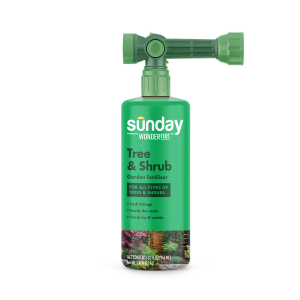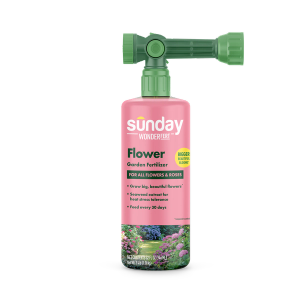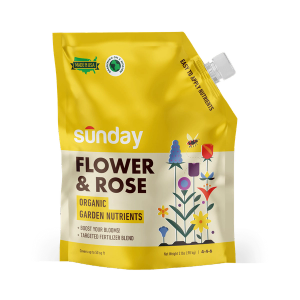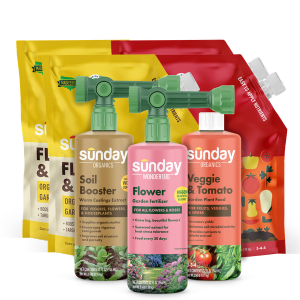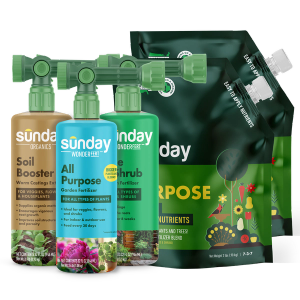What is a tree
Trees are a species with a single woody stem (a.k.a., trunk) and lateral-growing branches. They may be deciduous, evergreen, edible, ornamental, or flowering—and some are prized just for their beautiful foliage.
Tree planting tools and materials
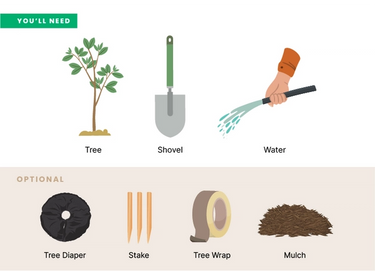
Before you plant
We get it—you’re probably very eager to get planting! But putting in a little prep now will set you on the path to long-term success.
Check the calendar
Fall is the best time to plant most trees; spring is the second best time. But you don’t have to worry about figuring that out! Sunday will ship your tree at the right time for planting; all you have to do is plant ASAP after receiving and unboxing your tree.
Call before you dig
To protect yourself and your utilities by calling 811 a few days before you dig to have someone come map your buried utility lines.
Location, location, location
It may be tempting to plant a tree for aesthetics alone, but remember you’re dealing with a living species that has needs. Consider the following when choosing a planting site:
- Mature tree size
- Sun requirements
- Moisture needs & availability
- What nearby plants might be impacted by tree growth (shade, water competition, etc.)
Sunday Tip:
Species-specific information on location, spacing, sun requirements, mature size, and more is usually available on a plant tag. If you bought your plant from Sunday, this info is available from our online plant product pages.
How to plant your tree
Prep
- Dig a hole 2–3x wider than the root mass and just deep enough for the topmost roots to sit level with the surface.
- Remove any rocks and debris.
- Loosen soil along the sides but not on the bottom of the hole; you don’t want the tree to sink after you plant.
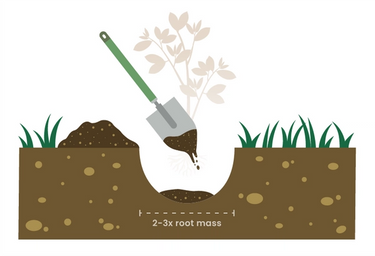
Plant
- Remove from the pot, gently separate the roots, and place the tree in the hole, making sure the stem is straight and not leaning.
- Make sure the topmost roots are level with the soil surface.
- Fill back in with soil, and water gently to allow soil to settle and ensure the tree is secure.
- Optional steps:
- Create a 3-inch-tall “water ring” around the root ball with extra soil.
- Install a watering device such as a tree diaper.
- Top with 2–4 inches of mulch.
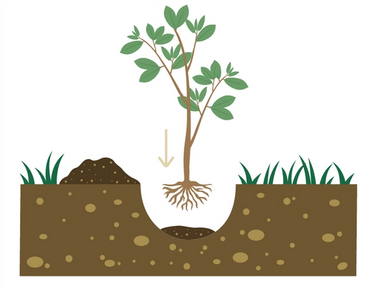
Sunday Tip:
Mulching around your tree can promote moisture retention, maintain even soil temps, and discourage weed growth. And it’s easy! A thin layer of shredded bark, leaves, straw, or other organic matter works great.
Water
- Water immediately after planting, then keep the soil moist (but not saturated!) by watering every 2–3 days for 12 weeks. After that you can cut back to weekly watering through the growing season.
- Sufficient water is key in these early days—but remember you can also give too much of a good thing. Improper watering is one of the main reasons trees fail within a few years of planting.
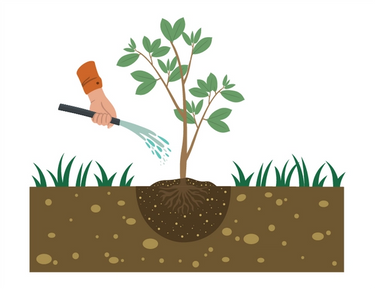
Proud tree grower
Congrats! You’re now the proud owner of an ornamental, shade, or fruit tree. And if you still need to buy a tree—or you'd just like to add more to the mix—you can find your new PFF (plant friend forever) here.
Let’s get social!
We’d love for you to share your planting journey with us! Tag those proud plant parent pics with #plantsofsunday on Instagram.
Need help with your Sunday live plant purchase? We're here to help!
- (415) 903-6932
- [email protected]
Cited sources
Center for Agriculture, Food, and the Environment at UMass Amherst. Landscape: Guidelines for Planting Trees and Shrubs.
Cornell University. The Cornell Guide for Planting and Maintaining Trees and Shrubs.
University of Maryland Extension. Planting a Tree or Shrub.
University of Minnesota Extension. Planting and transplanting trees and shrubs | UMN Extension.







